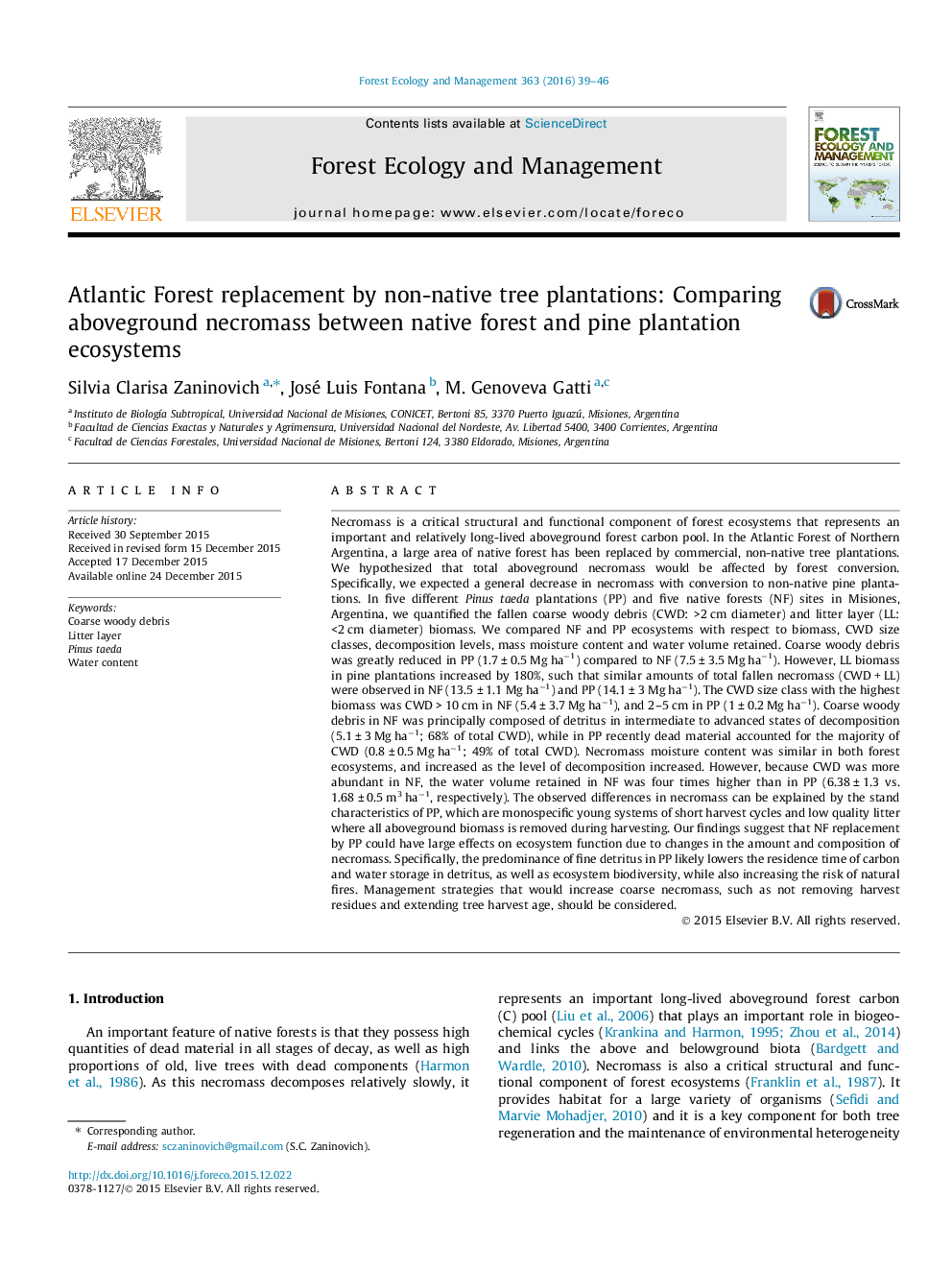| کد مقاله | کد نشریه | سال انتشار | مقاله انگلیسی | نسخه تمام متن |
|---|---|---|---|---|
| 86009 | 159157 | 2016 | 8 صفحه PDF | دانلود رایگان |
• We studied fine and coarse necromass in native forest and non-native pine plantations.
• Total fallen necromass was similar in both ecosystems.
• Native forest had similar quantities of litter layer and coarse woody debris.
• Pine plantations were dominated by litter layer, which comprised 90% of necromass.
• Changes affected water volume and could impact the carbon cycle, fire and diversity.
Necromass is a critical structural and functional component of forest ecosystems that represents an important and relatively long-lived aboveground forest carbon pool. In the Atlantic Forest of Northern Argentina, a large area of native forest has been replaced by commercial, non-native tree plantations. We hypothesized that total aboveground necromass would be affected by forest conversion. Specifically, we expected a general decrease in necromass with conversion to non-native pine plantations. In five different Pinus taeda plantations (PP) and five native forests (NF) sites in Misiones, Argentina, we quantified the fallen coarse woody debris (CWD: >2 cm diameter) and litter layer (LL: <2 cm diameter) biomass. We compared NF and PP ecosystems with respect to biomass, CWD size classes, decomposition levels, mass moisture content and water volume retained. Coarse woody debris was greatly reduced in PP (1.7 ± 0.5 Mg ha−1) compared to NF (7.5 ± 3.5 Mg ha−1). However, LL biomass in pine plantations increased by 180%, such that similar amounts of total fallen necromass (CWD + LL) were observed in NF (13.5 ± 1.1 Mg ha−1) and PP (14.1 ± 3 Mg ha−1). The CWD size class with the highest biomass was CWD > 10 cm in NF (5.4 ± 3.7 Mg ha−1), and 2–5 cm in PP (1 ± 0.2 Mg ha−1). Coarse woody debris in NF was principally composed of detritus in intermediate to advanced states of decomposition (5.1 ± 3 Mg ha−1; 68% of total CWD), while in PP recently dead material accounted for the majority of CWD (0.8 ± 0.5 Mg ha−1; 49% of total CWD). Necromass moisture content was similar in both forest ecosystems, and increased as the level of decomposition increased. However, because CWD was more abundant in NF, the water volume retained in NF was four times higher than in PP (6.38 ± 1.3 vs. 1.68 ± 0.5 m3 ha−1, respectively). The observed differences in necromass can be explained by the stand characteristics of PP, which are monospecific young systems of short harvest cycles and low quality litter where all aboveground biomass is removed during harvesting. Our findings suggest that NF replacement by PP could have large effects on ecosystem function due to changes in the amount and composition of necromass. Specifically, the predominance of fine detritus in PP likely lowers the residence time of carbon and water storage in detritus, as well as ecosystem biodiversity, while also increasing the risk of natural fires. Management strategies that would increase coarse necromass, such as not removing harvest residues and extending tree harvest age, should be considered.
Journal: Forest Ecology and Management - Volume 363, 1 March 2016, Pages 39–46
